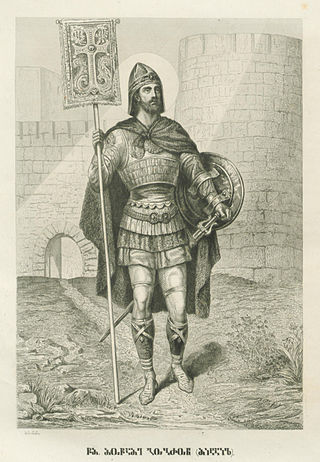Top Qs
Timeline
Chat
Perspective
Gobron
From Wikipedia, the free encyclopedia
Remove ads
Gobron (Georgian: გობრონი, romanized: gobroni) also known as Mikel-Gobron or Michael-Gobron (მიქელ-გობრონი) (died November 17, 914) was a Christian Georgian military commander who led the defense of the fortress of Q'ueli against the Sajid emir of Azerbaijan. When the fortress fell after a 28-day-long siege, Gobron was captured and beheaded, having rejected inducements to convert to Islam. Shortly after his death Gobron became the subject of the hagiography authored by Bishop Stephen of T'beti[1] and a saint of the Georgian Orthodox Church, which commemorates him on November 17 (O.S., which equates to November 30 on the Gregorian calendar).[2] His martyrdom is also mentioned by the medieval Georgian and Armenian chronicles.[3]
Remove ads
Biography
Summarize
Perspective
Gobron is a subject of The Passion of the Holy Martyr Gobron, who was Abducted from the Castle of Q'ueli (წამებაჲ წმიდისა მოწამისა გობრონისი, რომელი განიყვანეს ყუელის ციხით), composed by Bishop Stephen of T'beti (Stepane Mtbevari) at the behest of the Georgian Bagratid prince Ashot I of Tao between 914 and 918.[1] The narrative of Gobron's martyrdom unfolds against the background of the military expedition by Yusuf Ibn Abi'l-Saj, the Sajid emir of Azerbaijan, in Georgia in 914. This campaign was one of the last major attempts on the part of the Abbasid Caliphate to retain its crumbling hold of the Georgian lands, which, at that time, were a patchwork of rival, native states and Muslim holdings.[4]
Yusuf Ibn Abi'l-Saj, the Abul-Kasim of the medieval Georgian sources, invaded Georgia from Armenia. He advanced, through the Muslim emirate of Tiflis, into Kakheti, whence he moved into Kartli and invaded Samtskhe and Javakheti. Unable to seize hold of the fortress of Tmogvi, the emir laid siege to Q'ueli, which was then in possession of the Georgian Bagratid prince Gurgen of Tao. Q'ueli held out for 28 days: the young commander Gobron, whose original name—we are told by his biography—was Mikel (Michael), mounted a fierce resistance and made a series of sorties, but he finally felt obliged to surrender to the emir. Despite the large ransom sent by Gurgen, Yusuf refused to release his prisoners and decided to hold onto Mikel-Gobron as well as 133 others. Gobron, despite Yusuf's multiple attempts, firmly rejected to convert to Islam. According to The Passion of the Holy Martyr Gobron, the Georgian commander who was stubbornly refusing Yusuf's proposal, was ordered to bow down for execution. After the first strike of the sword, Gobron made the sign of the cross with blood on his forehead and exclaimed, "I thank you, Lord Jesus Christ, that you have accounted me, the most contemptible and chief among sinners, worthy to lay down my life for your sake!". The enraged Muslim general ordered the rest of the men to be massacred and their bodies left to the wild beasts.[5]
Gobron's defense of Q'ueli, his capture and execution are briefly described by the 11th-century anonymous Chronicle of Kartli, part of the Georgian Chronicles, which makes reference to the more detailed account by Stephen of T'beti. The execution of Mik'ayel, of Gogarene,[6] is also mentioned by the 10th-century Armenian historian John of Draskhanakert and later by his compatriot Stephen of Taron.[3]
Remove ads
References
External links
Wikiwand - on
Seamless Wikipedia browsing. On steroids.
Remove ads

